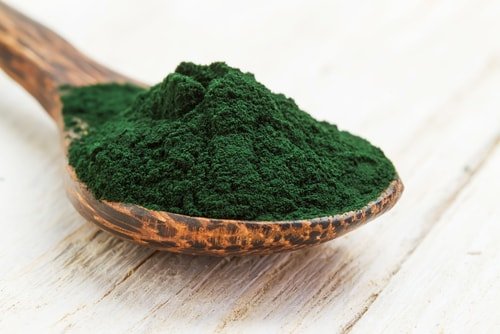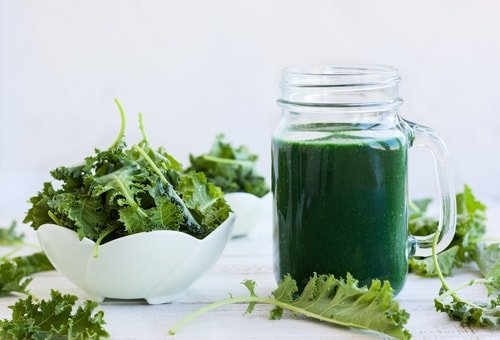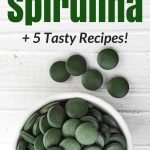7 Superfood Benefits of Spirulina + 5 Tasty Recipes
The superfood benefits of spirulina, a green algae, include weight loss, improved brain function, anti-inflammatory properties, and so much more! We’ll talk about the many health benefits and follow them up with 5 delicious spirulina recipes!
Spirulina’s history as a superfood dates back to at least the 9th century. It began to be produced commercially in 1970.
In 1988, NASA published a report proposing that spirulina could be grown in space and used in the astronauts’ diet (1). Today, you can buy it in powder or pill form from just about any health food retailer.
Why would you consume spirulina?
Well, it’s a quick and easy way to take in the following nutrients (2):
- Protein
- Thiamin
- Riboflavin
- Niacin
- Copper
- Iron
- Magnesium
- Potassium
And has all of these health benefits:
This post may contain affiliate links, which helps keep this content free. Please read our disclosure for more info.
1. Spirulina can help you lose weight.
It’s not a magical weight loss pill, but spirulina can help you maintain healthy weight loss. It’s packed with nutrients and contains 4 grams of protein and fiber in just one 20-calorie tablespoon.
When your body is getting the nutrition it needs, it’s less likely to send you signals that make you binge on foods that give you a quick pick-me-up, like sugar. The high protein can help you build muscle and stay full for longer after you eat it.
Research also shows that spirulina can help control blood sugar (3). Evidence shows that the seaweed helps reverse insulin resistance (4).
If your weight issues are linked to insulin resistance, this benefit can help you lose weight.
2. Spirulina improves brain function.
While we can’t guarantee that you’ll gain IQ points, you can prevent memory loss from oxidative stress to brain cells if you consume spirulina (5).
Research also shows that taking just two grams a day can improve academic performance. Consuming spirulina can also make you more productive and focused (6, 7).
This is especially important as you age. Scientists have found that taking spirulina can reduce your risk of developing degenerative brain disorders, like Alzheimer’s or Parkinson’s (8).
3. Spirulina is anti-inflammatory.

Some laboratory studies show that spirulina is just as effective as nonsteroidal anti-inflammatory drugs in reducing inflammation (9).
Phycocyanin, one of the compounds that gives spirulina its bright blue-green color, can impede the production of molecules that signal inflammation. It has been found to reduce swelling and histamine release in inflamed tissues.
Spirulina may help treat leaky gut and inflammatory bowel disease.
4. Spirulina can help with your allergies.
If you experience allergies or hay fever, your immune system is responding to particles in the environment by making you sneezy and itchy. You may become congested and sniffly.
Spirulina is often used as an herbal remedy for seasonal allergies, and with good reason (10). Evidence shows that spirulina can minimize allergy symptoms without causing side effects (11).
5. Spirulina can boost your immunity.
According to Natural News, spirulina encourages your body to produce more red and white blood cells. This can help you fight viruses and bacteria (12).
6. Spirulina can fight cancer.
Whenever you see a statement that a supplement fights cancer, it seems too good to be true. However, evidence really does suggest that spirulina’s high levels of antioxidants can help kill cancer cells (13).
It is especially effective in shrinking precancerous lesions in the mouth (14).
This doesn’t make spirulina a miracle cure for cancer. However, it does suggest that adding it to a healthy diet can help keep your cells and DNA healthy, possibly reducing your risk of cancer.
7. Spirulina is good for your liver.
If you’re not a heavy drinker or don’t have liver disease, you might overlook this one. However, keeping your liver healthy can help with digestion, weight management, and nutrient absorption.
All of those things impact your health. Your liver is responsible for managing cholesterol and secretes enzymes to aid in digestion.
If your liver isn’t working properly, so much of your digestion and health suffers too.
Spirulina Recipes
So how can you take spirulina? Sure, you can take it in pill form, but it can be tough to remember to swallow a pill every day.
Plus, it’s more fun to turn it into a tasty recipe, and cooking with spirulina powder is a good way to sneak it into the kids’ food.
Here are 5 ways to get your spirulina in throughout the day.
Green Spirulina Smoothie

Some people don’t like the taste of spirulina. Adding it to a smoothie masks the flavor, so all you get is a vivid color and health-boosting effects.
To make a green spirulina smoothie, blend a handful of spinach with a cup of pineapple, half a cucumber, ice, and kombucha or water. Add in a tablespoon or two of powdered spirulina.
Green Spirulina Wrap
This makes a great snack or lunch. It’s light, delicious and packed with nutrients.
Grab a few of the largest collard leaves you can find. Cut off the part of the stem that sticks out the bottom, and blanch them in boiling water for 5 seconds (that’s right, only 5 seconds).
Mash up an avocado with a tablespoon of powdered spirulina, lime juice, a sprinkle of cumin, a sprinkle of sea salt and a sprinkle of paprika. Spread it on an open collard leaf.
Add some shredded carrot, finely chopped cucumber and 1 tablespoon of hemp seeds and roll up like a burrito.
Mint “Ice Cream”
If you love mint chocolate chip ice cream but don’t love green food coloring, try making it with spirulina instead. This recipe is dairy free.
Soak 2 cups of raw, unsalted cashews in water overnight. Drain and add to a high-powered blender with a handful of fresh mint leaves (or 1 teaspoon of peppermint extract), ¼ cup maple syrup, ¼ cup water, 2 tablespoons of coconut oil and ¼ teaspoon of spirulina.
Blend it until smooth, then place in the freezer in a covered container. Stir it every hour until it freezes up and resembles ice cream.
Optional: add cacao nibs before you freeze it!
Spirulina Energy Balls
In a high-powered blender, pulse ¼ cup of cashews with ¼ cup of rolled oats until it looks like a coarse flour. Add 2 chopped dates, 2 tablespoons maple syrup, 1 tablespoon shredded coconut and ¼ teaspoon of spirulina powder.
Blend until it looks like a sticky dough. Remove it from the blender and roll it into balls.
Roll the balls in sesame seeds, if desired, and store in the fridge.
Spirulina Peanut Butter Fudge
Melt together 1/3 cup coconut oil, 1/3 cup raw cacao powder, 1 tablespoon spirulina powder and 1/3 cup of honey or maple syrup.
Pour into a parchment-lined baking sheet, bowl or dish. It should be small enough that the mixture fills it to about ½-inch thick. Swirl in 1/3 cup of melted peanut butter.
Place in the refrigerator for several hours, until it hardens. Cut into pieces with a knife.
This must be eaten cold, or it will melt.
Where Can I Get Spirulina?
I buy it off Amazon because that is what is the most convenient for me. You can also find it at health food stores, although Amazon is usually a little bit cheaper.
If you’re looking for it in powder form, we use and recommend Healthworks. It’s organic and a great price! You can get it here.
If you’re looking for it in pill form, we use and recommend: Now Foods (also organic). I often chew these during the day to keep myself from snacking. They make me really thirsty, so it helps me get in some extra water throughout the day! You can get it here.
If you liked this article on the superfood benefits of spirulina, please feel free to leave us a comment or question below!

